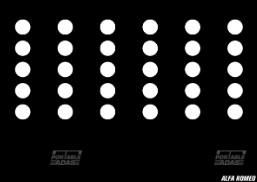Aligning Vision: Mastering ADAS Calibration for Forward Facing Cameras
In the ever-evolving world of automotive technology, advanced driver assistance systems (ADAS) are becoming increasingly crucial for enhancing vehicle safety and performance. Among these systems, forward-facing cameras play a vital role in enabling features like lane-keeping assistance, adaptive cruise control, and collision avoidance. As vehicles become more sophisticated, the need for precise calibration of these cameras is paramount to ensure that they function optimally.
Mastering ADAS calibration for forward-facing cameras not only improves the accuracy of these safety features but also helps prevent accidents and enhances the overall driving experience. With the growing demand for portable and affordable calibration solutions, options like the Affordable Auto Glass ADAS Target System and the Carcal ADAS system are gaining traction among technicians and auto repair shops. These tools offer an effective way to perform accurate static calibration without breaking the bank, especially with prices for effective ADAS systems now under $5500. Understanding the nuances of this calibration process is essential for anyone in the automotive field looking to stay ahead in this rapidly advancing landscape.
Understanding ADAS Calibration
ADAS calibration is a crucial process that ensures the various advanced driver-assistance systems function as intended. These systems rely on sensors, cameras, and radar to provide features like lane keeping assistance, adaptive cruise control, and automatic emergency braking. Proper calibration is essential because even minor misalignments can lead to incorrect readings, which may compromise safety and performance. With ADAS System Portable growing complexity of vehicles, especially those equipped with forward-facing cameras, understanding the calibration process has never been more important.
The calibration process can be categorized into two main types: static and dynamic. Static calibration typically involves the use of specialized targets positioned at specific distances from the vehicle. For instance, systems like the Subaru mono calibration target are designed for precise alignment and measurement. On the other hand, dynamic calibration occurs while the vehicle is in motion, often requiring specific conditions to be met, such as driving at particular speeds and on designated road types. Both methods must be conducted carefully to ensure all ADAS features function correctly post-calibration.
As technology progresses, accessible and affordable ADAS calibration tools have become a necessity for auto repair shops and technicians. Portable ADAS systems, like the affordable auto glass ADAS target system or Carcal ADAS options, offer solutions that fit within budget constraints, often under 5500. These options empower technicians to provide accurate calibration without heavy investments in costly equipment. In an industry where safety is paramount, mastering ADAS calibration is not just a technical requirement; it's an essential aspect of modern automotive service.
Choosing the Right Portable ADAS Solutions
When selecting the ideal portable ADAS solutions, it is essential to consider the specific calibration needs of forward facing cameras. The market offers a variety of options, such as the Carcal ADAS system, which provides a comprehensive setup for both static and dynamic calibration processes. Look for systems that are versatile and compatible with multiple vehicle makes and models, ensuring they can meet the requirements of diverse service environments.
Affordability is another critical factor. With options like the Affordable Auto Glass ADAS Target System and other calibration stands available for under 5500, you can find a suitable solution that balances pricing and functionality. Ensure that any system you choose maintains high precision and can be easily integrated into your existing workflow, raising the standard of your calibration capabilities without straining your budget.
Lastly, consider the portability and ease of setup. A static ADAS calibration stand should be lightweight and user-friendly, enabling technicians to quickly set up and perform calibrations efficiently. Features such as a Subaru mono calibration target or an adjustable design can enhance usability. By focusing on these aspects, you can ensure that your investment in a portable ADAS solution yields reliable results and enhances your service offering in automotive calibration.
Cost-Effective Calibration Techniques
In the realm of ADAS calibration, finding cost-effective solutions is essential for many automotive professionals. One of the most effective approaches is utilizing a Portable ADAS system. These systems, like the Carcal ADAS, offer high-quality calibration without the hefty price tag. Their design ensures easy transport and setup, making it possible to perform necessary calibrations on-site, significantly reducing labor costs and enhancing service flexibility.
Another viable option is the Affordable Auto Glass ADAS Target System. This system is designed to provide accurate calibration results while remaining budget-friendly. It caters to various vehicle models, including Subaru, which is particularly useful for technicians dealing with diverse inventory. By investing in affordable calibration stands that maintain high performance, shops can offer reliable services without overwhelming their budget.
Lastly, using a Static ADAS calibration stand under $5500 enables workshops to harness precision in their calibration processes. These stands provide a solid foundation for a repeatable and accurate calibration experience, serving as a crucial tool in the technician's arsenal. By combining these cost-effective techniques, automotive businesses can maximize efficiency, customer satisfaction, and profitability while staying ahead in this competitive market.
